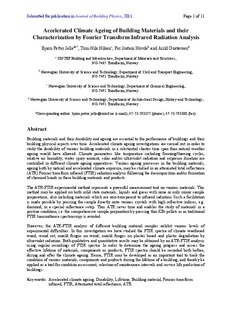| dc.contributor.author | Jelle, Bjørn Petter | |
| dc.contributor.author | Nilsen, Tom-Nils | |
| dc.contributor.author | Hovde, Per Jostein | |
| dc.contributor.author | Gustavsen, Arild | |
| dc.date.accessioned | 2017-04-03T11:39:45Z | |
| dc.date.available | 2017-04-03T11:39:45Z | |
| dc.date.created | 2011-10-20T19:20:54Z | |
| dc.date.issued | 2012 | |
| dc.identifier.citation | Journal of Building Physics. 2012, 36 (1), 99-112. | nb_NO |
| dc.identifier.issn | 1744-2591 | |
| dc.identifier.uri | http://hdl.handle.net/11250/2436603 | |
| dc.description.abstract | Building materials and their durability and aging are essential to the performance of buildings and their building physical aspects over time. Accelerated climate aging investigations are carried out in order to study the durability of various building materials in a substantial shorter time span than natural weather aging would have allowed. Climate parameters such as temperature that includes freezing/thawing cycles, relative air humidity, water spray amount, solar and/or ultraviolet (UV) radiation and exposure duration are controlled in different climate aging apparatuses. Various aging processes in building materials, aging both by natural and accelerated climate exposure, may be studied in an attenuated total reflectance (ATR) Fourier transform infrared (FTIR) radiation analysis following the decomposition and/or formation of chemical bonds in these building materials and products.
ATR-FTIR analysis of different building material samples exhibit various levels of experimental difficulties. In this investigation we have studied the FTIR spectra of climate-weathered wood, wood rot, mold fungus on wood, mold fungus on plasterboard, and plastic degradation by UV radiation. Both qualitative and quantitative results may be obtained by an ATR-FTIR analysis. In order to determine the aging progress and assess the effective lifetime of materials, components, or products, FTIR spectra should be recorded before, during, and after the climate aging. Hence, FTIR may be developed as an important tool to track the condition of various materials, components, and products during the lifetime of a building, and thereby applied as a tool for condition assessment, selection of maintenance intervals, and service life prediction of buildings. | nb_NO |
| dc.language.iso | eng | nb_NO |
| dc.publisher | SAGE Publications | nb_NO |
| dc.title | Accelerated climate aging of building materials and their characterization by Fourier transform infrared radiation analysis | nb_NO |
| dc.type | Journal article | nb_NO |
| dc.type | Peer reviewed | nb_NO |
| dc.source.pagenumber | 99-112 | nb_NO |
| dc.source.volume | 36 | nb_NO |
| dc.source.journal | Journal of Building Physics | nb_NO |
| dc.source.issue | 1 | nb_NO |
| dc.identifier.doi | 10.1177/1744259111423367 | |
| dc.identifier.cristin | 846724 | |
| dc.description.localcode | © The Author(s) 2011. Reprints and permissions: sagepub.co.uk/journalsPermissions.nav. This is the authors' accepted and refereed manuscript to the article. | nb_NO |
| cristin.unitcode | 194,64,35,0 | |
| cristin.unitcode | 194,66,30,0 | |
| cristin.unitcode | 194,61,25,0 | |
| cristin.unitname | Institutt for bygg, anlegg og transport | |
| cristin.unitname | Institutt for kjemisk prosessteknologi | |
| cristin.unitname | Institutt for byggekunst, historie og teknologi | |
| cristin.ispublished | true | |
| cristin.fulltext | original | |
| cristin.fulltext | postprint | |
| cristin.qualitycode | 2 | |
